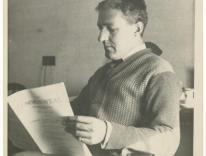In my column in the latest issue of Commonweal, "Nothing to Celebrate," I wrote about what seems to me to be a strange unwillingness on the part of gun-control opponents to criticize American gun culture, or acknowledge its effects: "Among conservatives actually willing to address proposed restrictions on guns, I find a chilling lack of reference to the human cost of guns in America."
For example: in the February 11 issue of The National Review -- the one that featured a cover image taken from a WWI propaganda poster, with the patriotic female figure holding aloft an assault rifle instead of a flag, and the defiant headline "Why We Cling" -- the editors dismiss the idea of limiting high-capacity ammunition clips by pointing out that Adam Lanza's victims at Sandy Hook Elementary were all small children who probably wouldn't have been able to take him down even if he'd had to stop and reload. I found that argument chilling once; they liked it so much they made it twice in that same issue. Elsewhere they expressed outrage at the implication that gun-control opponents dont feel terrible about slaughtered children, but for the most part those feelings were kept in check. The vulnerability of Newtown's victims was considered just long enough to wave away any attempts to limit the killing power of weapons like the ones Lanza used. We do not suffer from a dearth of gun-related statutes on the books, the editors insisted, but they were unusually reluctant to identify what we do suffer from. Instead, they offered resignation: Murderers will always be with us."
As I wrote in my column, this seemed an odd stance coming from a venue that makes frequent use of the labels "culture of life" and "culture of death." Oh, the culture comes in for criticism sometimes when gun violence erupts -- but always the popular culture, video games and Hollywood; never the culture of gun shows and shooting ranges; never the fetishizing of military-grade weaponry or high-capacity clips. Somehow all of that has taken on a noble sheen -- it's a proud American tradition. Just like our exceptionally high firearm fatality rate.
It's true: not all of the restrictions that have been suggested recently are direct responses to the circumstances of the Newtown shooting. But why should that be the only relevant criterion? If they address the epidemic of gun violence in this country -- if they even could slow the death toll -- arent they worth considering on their own merits? What's happening now is about more than just Newtown. Me again:
[M]ass shootings are only the tip of the iceberg. Thirty thousand Americans die from gunshot wounds every year. More than three hundred of them are children under the age of fifteen. That steady drip of senseless lossand the knowledge that no other developed nation has a firearm fatality rate that even approaches ours -- is what really lies behind the calls for restrictions on guns. Horrors like the Newtown massacre invite everyone to stop and take notice.
And people have. I follow a Twitter account (@GunDeaths) that attempts to keeps track of every gun death in North America regardless of cause and without comment. Its tweets come steadily, tolling one tragedy after another: a murder-suicide in Salt Lake City; a thirteen-year-old who shot herself in California; a man found dead in a car in Cleveland. The online magazine Slate partnered with Gun Deaths to compile the data; last time I checked, their running tally of firearm deaths since Newtown stood at 2,453. The circumstances differ; the solutions will too. But they are all the result of what Obama has called "violence that we cannot accept as routine." That's why I was so pleased to see Cardinal Timothy Dolan take a moment to acknowledge the problem and frame it as a sign of a culture that devalues human life. If we're talking about guns and not not talking about the lives lost, we're fooling ourselves.


